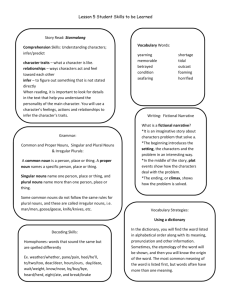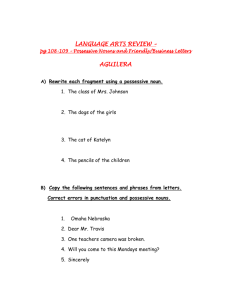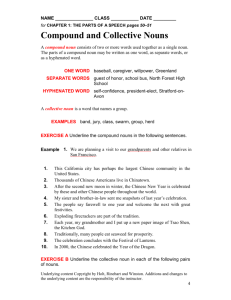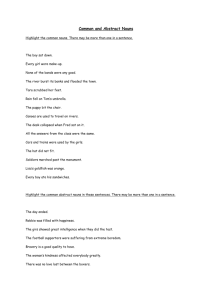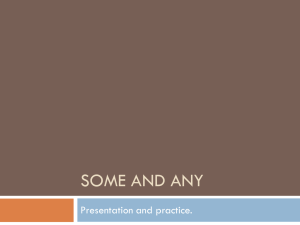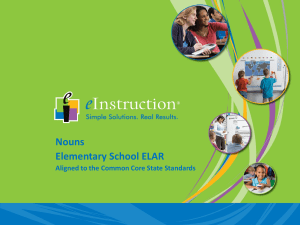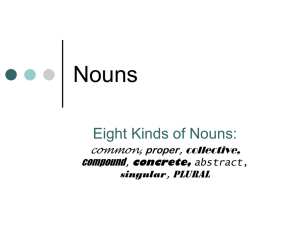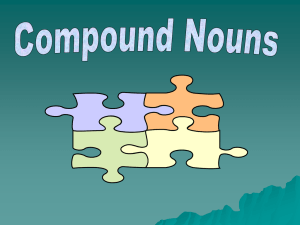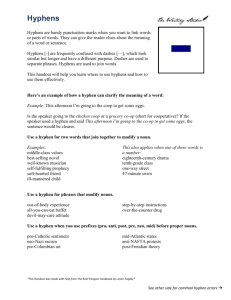Technical Writing
advertisement
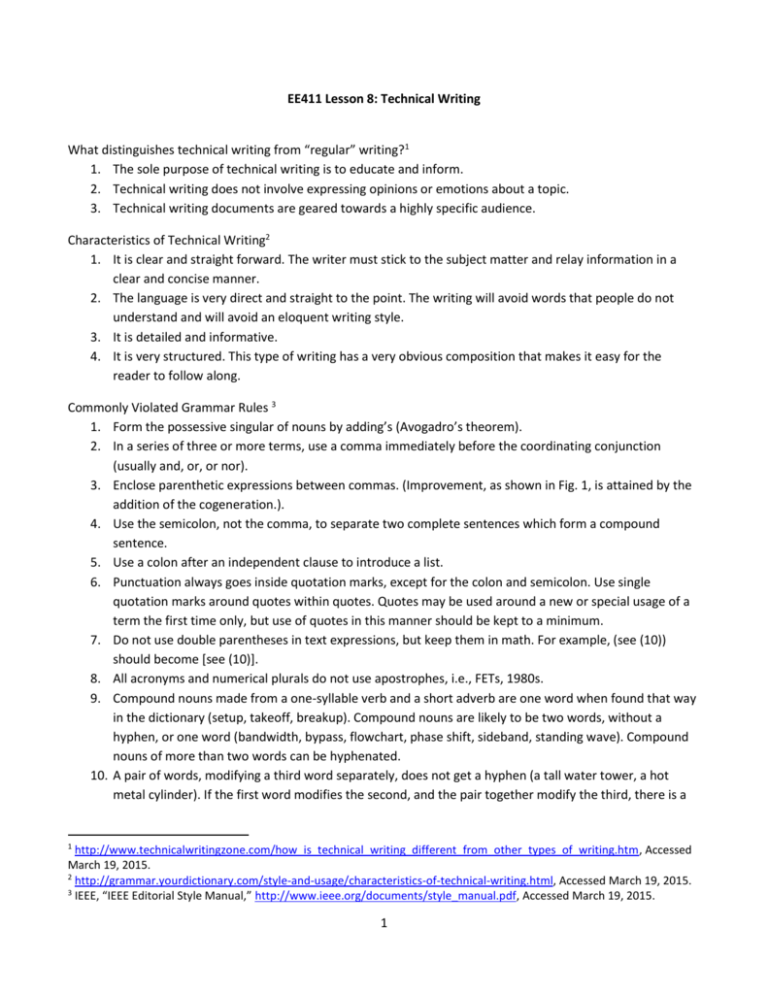
EE411 Lesson 8: Technical Writing What distinguishes technical writing from “regular” writing?1 1. The sole purpose of technical writing is to educate and inform. 2. Technical writing does not involve expressing opinions or emotions about a topic. 3. Technical writing documents are geared towards a highly specific audience. Characteristics of Technical Writing2 1. It is clear and straight forward. The writer must stick to the subject matter and relay information in a clear and concise manner. 2. The language is very direct and straight to the point. The writing will avoid words that people do not understand and will avoid an eloquent writing style. 3. It is detailed and informative. 4. It is very structured. This type of writing has a very obvious composition that makes it easy for the reader to follow along. Commonly Violated Grammar Rules 3 1. Form the possessive singular of nouns by adding’s (Avogadro’s theorem). 2. In a series of three or more terms, use a comma immediately before the coordinating conjunction (usually and, or, or nor). 3. Enclose parenthetic expressions between commas. (Improvement, as shown in Fig. 1, is attained by the addition of the cogeneration.). 4. Use the semicolon, not the comma, to separate two complete sentences which form a compound sentence. 5. Use a colon after an independent clause to introduce a list. 6. Punctuation always goes inside quotation marks, except for the colon and semicolon. Use single quotation marks around quotes within quotes. Quotes may be used around a new or special usage of a term the first time only, but use of quotes in this manner should be kept to a minimum. 7. Do not use double parentheses in text expressions, but keep them in math. For example, (see (10)) should become [see (10)]. 8. All acronyms and numerical plurals do not use apostrophes, i.e., FETs, 1980s. 9. Compound nouns made from a one-syllable verb and a short adverb are one word when found that way in the dictionary (setup, takeoff, breakup). Compound nouns are likely to be two words, without a hyphen, or one word (bandwidth, bypass, flowchart, phase shift, sideband, standing wave). Compound nouns of more than two words can be hyphenated. 10. A pair of words, modifying a third word separately, does not get a hyphen (a tall water tower, a hot metal cylinder). If the first word modifies the second, and the pair together modify the third, there is a 1 http://www.technicalwritingzone.com/how_is_technical_writing_different_from_other_types_of_writing.htm, Accessed March 19, 2015. 2 http://grammar.yourdictionary.com/style-and-usage/characteristics-of-technical-writing.html, Accessed March 19, 2015. 3 IEEE, “IEEE Editorial Style Manual,” http://www.ieee.org/documents/style_manual.pdf, Accessed March 19, 2015. 1 11. 12. 13. 14. hyphen between the pair (a high-frequency signal, a second-order equation). The exception to this is the adverb ending in “ly,” which needs no hyphen to join it to the next word. A hyphen is not used after the comparative or the superlative (a higher order equation, a worst case value, nearest neighbor method). Do not hyphenate chemical compounds (sodium chloride crystals). Alloys and mixtures take the en dash (Ni–Co, He–Ne laser). Do not use commas between adjectives (a planar equiangular spiral antenna). Do not hyphenate predicate adjectives (… is well known, …is second order). Compound verbs are generally hyphenated (arc-weld, freeze-dry). Keep the hyphen when using the participles of such verbs as adjectives (freeze-dried, arc-welded). However, verbs with up, out, down, off, on, etc., do not have a hyphen, although the nouns formed from them may be hyphenated or one word (Verb: set up, break down, read out; Noun: setup, breakdown, readout). Words and Phrases Often Confused4 Affect: to change or modify (verb). Effect: result (noun); cause (verb). Increasing the capacitance will affect the time constant of the circuit. What is the likely effect on the circuit of increasing the resistance? Alternate: a substitute. Alternative: a matter of choice. When a road undergoing maintenance is closed to traffic, you have to take an alternate route. But when an under-construction road is still accessible to traffic, you might choose to take an alternative route to avoid congestion. Among: involves three or more things, but considered as a group. Between: involves two or more things, but considers each individually. The negotiations between Brazil, Argentina, and Chile are going well. The negotiations among the countries of South America are going well. Compare to: point out resemblances between different objects. Compare with: point out differences between same objects. A USNA education can be compared to a firehouse. When one compares USNA with USMA it is obvious that the former institution is vastly superior. Compose: Compose means to make up the constituent parts of. Comprise: Comprise means to consist of or to be composed of. The United States comprises 50 states. The United States is composed of 50 states. Many people would write that “the United States is comprised of 50 states” but that is incorrect.5 4 5 IEEE, “IEEE Editorial Style Manual,” http://www.ieee.org/documents/style_manual.pdf, Accessed March 19, 2015. http://grammarist.com/usage/compose-comprise/, Accessed March 19, 2015. 2 Farther: distance. Further: quantity. Bancroft Hall is farther from Rickover Hall than Maury Hall. This does not give midshipmen a further excuse to be late. Fewer: modifies plural nouns specifying countable units, e.g., fewer tubes. Less: modifies singular mass nouns and singular abstract nouns, e.g., less air. This problem set has fewer problems, but it doesn’t seem to be less work. Many: modifies plural nouns specifying countable units. Much: modifies singular mass nouns and singular abstract nouns. This problem set has many problems, but it doesn’t seem to be much work. Number: a quantity of countable units. Amount: a quantity of a singular mass noun or singular abstract noun. What amount of water should be added to this solution? It contains a number of components. Imply: something suggested though not expressed. Infer: something deduced from evidence. The professor implied that the topic was important. The student inferred that the topic was likely to be on the exam. Principal: chief, main, most important (adjective). Principle: a rule (noun). Many would say that the Golden Rule is the principal principle for communal life. Precede: come before. Proceed: continue, advance. This section was preceded by a list of commonly violated grammar rules. Before we proceed to the class exercise, there is one more set of frequently confused word pairs. That: (defining, restrictive). Which: (nondefining, nonrestrictive). The Van Gogh that was hanging in the foyer, which we purchased in 1929 for $10,000, was stolen Additional Resources On-line exercises to hone your grammar skills: http://writing.engr.psu.edu/exercises/index.html 3

